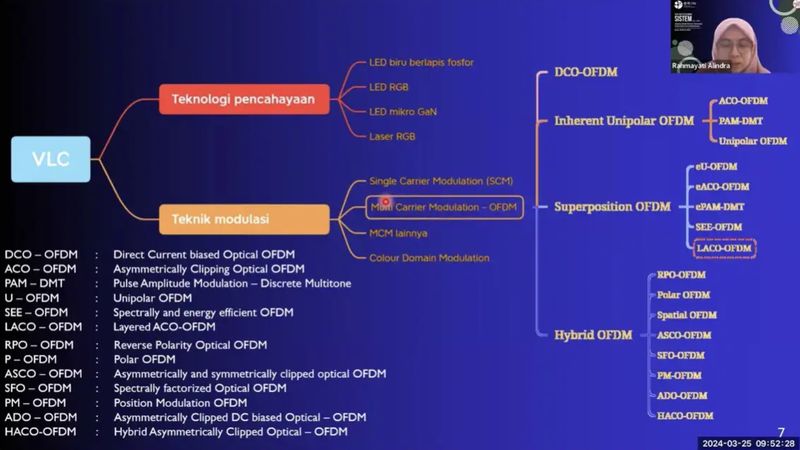The number of Indonesian internet users continues to grow, but on the other hand, the use of radio wave transmission technology is almost full. The National Research and Innovation Agency (BRIN) is researching visible light communication systems to meet internet access needs.
Rahmayati, a researcher at BRIN’s Electronics and Optical Research Center, explained that the existing condition of internet access relies on radio frequency (RF) transmission technology, such as bluetooth, zigbee, LoRaWAN, wifi, NB-IoT, 4G and others.
“Judging from the electromagnetic spectrum, RF has a bandwidth of 40 GHz, and this is almost full. Therefore, visible light communication (VLC) research emerged, which utilizes the visible light spectrum for communication,” Rahmayati said in a press release on Thursday (28/3/2024).
Read also:
Astronomy Expert BRIN: Hoax Earth Will Experience Darkness for 3 Days
The researchers saw an opportunity to go to a higher frequency, namely visible light, which has a bandwidth ten thousand times that of RF and has not yet been used for communication.
“According to existing studies, relying on radio frequency alone is not enough and leads to a spectrum crisis. So, the longer it will not be enough because there are more and more people using it,” Rahmayati added.
ADVERTISEMENT
Visible light communication systems or VLC when compared to radio frequencies have characteristics, including unlicensed spectrum for 430 THz – 790 THz is only used for lighting, not for communication. It supports 5G-6G and is good for indoor access.
Security is also higher and will not penetrate solid walls, large bandwidth, and low cost. Where, the utilization of light sources such as LEDs and added communication functions. Thus, adding value to the LED and minimizing the cost for communication.
“VLC is electromagnetic-free, so it is suitable for electromagnetic-prone areas such as hospital, petrochemical, and aircraft industries,” he said.
He further explained that VLC is supported by two techniques, namely lighting technology and modulation technique. The most potential modulation technique is multi-carrier modulation (MCM) based on orthogonal frequency division multiplexing (OFDM).

Meeting Indonesia’s internet access needs, BRIN studies visible light.Meeting Indonesia’s internet access needs, BRIN studies visible light. Photo: BRIN
He explained that this technique is further divided into four categories, namely DCO-OFDM (using the addition of DC bias), Inherent Unipolar OFDM (how to remove negative values by clipping techniques or using real values only), superposition OFDM (development of this unipolar OFDM, but made multilevel and layered to increase the spectral efficiency of the modulation technique), and hybrid OFDM (a combination of two modulations produced into one new modulation).
“Of the various modulation techniques, we refer to the layered asymmetrically clipped optical-orthogonal frequency-division multiplexing (LACO-OFDM) research. Existing LACO-OFDM research generally only explains the mathematical formula, then evaluates it with limited performance parameters and verifies it with stimulation,” he said.
“In this research, we propose LACO OFDM with a more complete evaluation of performance parameters, efficiency, verification (simulation, DSP to DSP, circuit) that is more thorough and lower cost,” Rahmayati added.
It was concluded that from the literature study conducted on various optical OFDM variants for VLC, the LACO OFDM technique is considered the most feasible to implement. This is based on the comparison of energy efficiency, spectral efficiency, PAPR, and computational complexity parameters.
He said that the design of transmitters and receivers has been carried out to build a visible light communication system with a point to point connection. Laboratory-scale transmission tests at a distance of one meter resulted in a bandwidth of 3 MHz at the transmitter and 2.5 MHz at the receiver.
“The implementation results of DCO-OFDM and ACO-OFDM on Xilinx Artix-35T FPGA show that both systems use eight percent of FPGA resources, relatively small power consumption, which is 0.081 W for DCO-OFDM, and 0.082 W for ACO-OFDM,” he detailed.
In addition, LACO OFDM with the proposed use of fixed-sized IFFT/FFT blocks is combined with subcarrier mapping settings. LACO OFDM consists of 3 layers, 16 16-point IFFT/FFT subcarriers, and QAM modulation on each subcarrier.
“It can be concluded that the simulation results show that the layered structure of LACO-OFDM produces spectral efficiency up to twice the spectral efficiency of ACO-OFDM. The design of LACO OFDM based on Intellectual Property (IP) Core for a 4-layer structure, 32 subcarriers, 32-point IFFT/FFT, and QAM 16 modulation allows reuse of all system components,” Rahmayati concluded.
source:
https://inet.detik.com/science/d-7267024/penuhi-kebutuhan-akses-internet-indonesia-brin-teliti-cahaya-tampak
